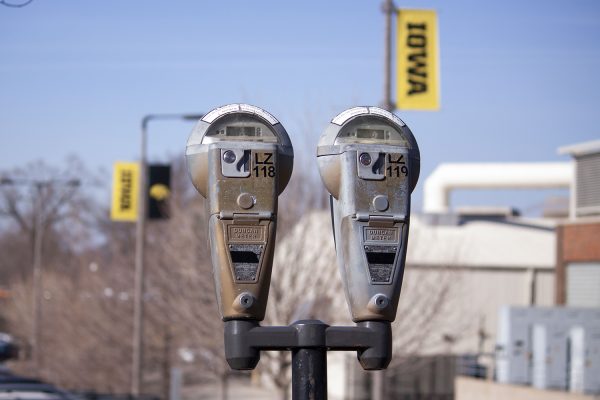Iowa City continues pothole-repair process
As the layers of snow melt across the Midwest, Iowa City faces a large, annoying obstacle — potholes.
A large pothole is seen outside of Peking Buffet in Coralville on Monday, April 1. As spring moves forward, Iowa City and Coralville will continue to fill potholes and other road disturbances.
April 1, 2019
Although spring has sprung in Iowa City, the thin veneer of birds singing and the mass consumption of allergy medicine is a mask for a much more sinister problem beneath our feet (and tires) — potholes.
In the aftermath of a brutal winter, the city has ramped up efforts to restore streets and thoroughfares. Brock Holub, the city superintendent of streets & traffic engineering, said crews are working around the clock to mend the damage.
“I mean this goes without saying, but snow is not good for road conditions,” he said. “There’s a constant cycle of freeze/thaw, freeze/thaw, and it certainly didn’t help that we had six-straight weeks of snow.”
According to pothole.info, many factors can contribute to the formation of potholes.
“The areas most prone to pothole development are where drainage is poor (particularly where roads dip, such as the trough under viaducts), where vehicular traffic is greatest — especially heavy vehicle traffic — and where poor maintenance allows small fissures to deteriorate,” the website said. “The vast majority of America’s highways were built in the 1950s through the 1970s. Most were built to last 50 years. With time, all the factors that compromise pavement add up. By the same token, some roads have lasted much longer than planned in part due to good maintenance.”
As of right now, Holub said, two pothole-filling crews are focusing on the arterial streets first, followed by bike lanes and special requests from Iowa City residents. Although his department handles both major roadways and smaller areas, Holub said streets with the most traffic are definitely a priority, because they have the highest likelihood of causing damage to vehicles.
RELATED: New app allows residents to report potholes, other troubles
Something many people may not realize, he said, is the difference between the asphalt used during the spring and summer.
“Companies don’t start producing what’s called ‘hot asphalt’ until mid-April,” he said. “This hot mix can’t be stored during the winter and other times throughout the year. For right now, we’re using a cold-mix asphalt that is compacted into the affected areas, and that acts as a temporary hold until we can use the other mixture.”
Eric Fisher, the streets & solid waste superintendent for Coralville, said there are pitfalls to using cold-mix asphalt, but crews have to use any tools at their disposal to clean up from a “brutal winter.”
“A majority of the potholes we’re seeing in Coralville are actually concentrated in a small area,” he said. “They’re on major roads, so we’re planning on continuing this maintenance into the summer. I will say, however, that we do use a high-performance mix to fill the holes.”
Although some Iowa City residents contact the police with regard to road conditions, Iowa City police Public Information Officer Derek Frank said law enforcement only gets involved when street conditions present a significant safety risk.
“The only time we’re going to get involved is when an obstacle has the ability to cause major inconveniences or risk to drivers,” he said.
Holub said he realizes the annoyance of post-winter street damage, but he assures residents that crews are working as fast as they can.
“We just want to make sure the roads are safe for everyone,” he said. “We’re as annoyed with potholes as everyone else.”





















